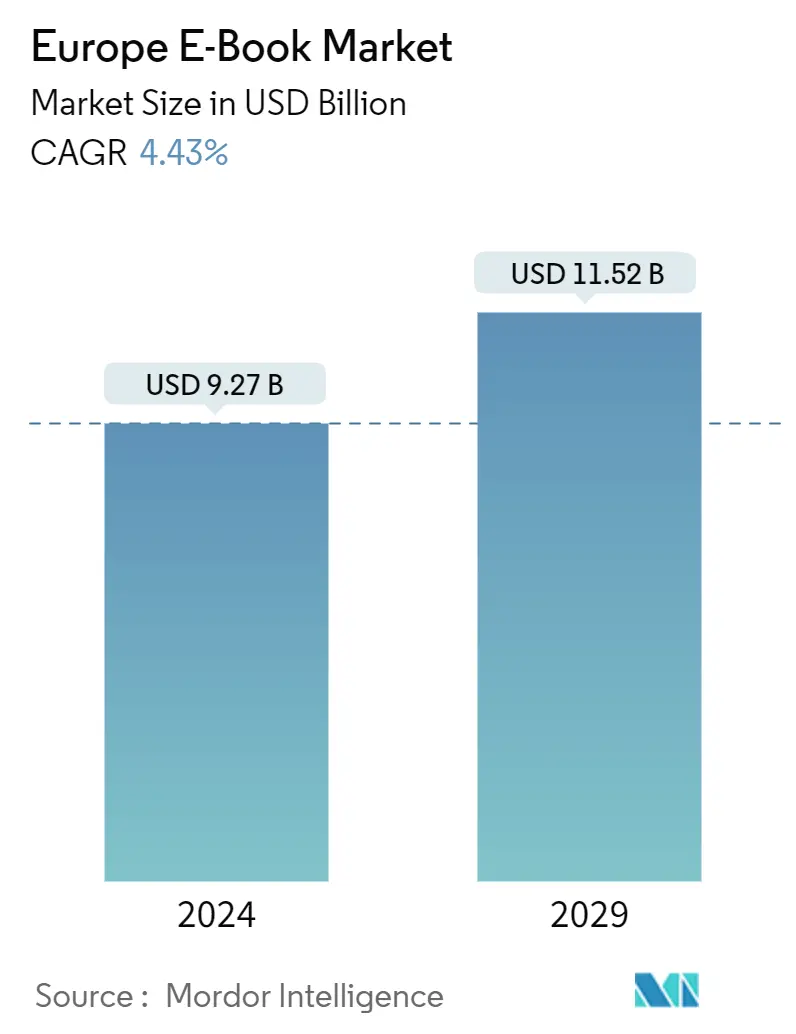Market Size of Europe E-Book Industry

| Study Period | 2019-2029 |
| Base Year For Estimation | 2023 |
| Market Size (2024) | USD 9.27 Billion |
| Market Size (2029) | USD 11.52 Billion |
| CAGR (2024 - 2029) | 4.43 % |
| Market Concentration | Low |
Major Players
*Disclaimer: Major Players sorted in no particular order |
Europe E-Book Market Analysis
The Europe E-Book Market size is estimated at USD 9.27 billion in 2024, and is expected to reach USD 11.52 billion by 2029, growing at a CAGR of 4.43% during the forecast period (2024-2029).
The growing number of devices capable of providing digital media and the increasing internet penetration have allowed consumers to access the media content of their choice. This transformation from offline to online is driving the European e-books market.
- The widespread availability and rising popularity of e-books are transforming the publishing industry, while the nature and scope of e-books changes differ significantly from company to company and genre to genre. With interactive e-books, and animated e-books, e-publishing businesses have enabled many publishers and authors to get their works to market faster and more advanced.
- Consumers were given the possibility to access media content of their own choice, with regards to information, entertainment or Social Activities, wherever they may be due to an increase in devices that are able to provide digital media and a rise in Internet penetration.
- Easy access to a wide selection of e-book libraries via applications or online services is growing internet consumption, resulting in low-cost alternatives to traditional delivery methods. e-book-related services, such as e-lending, have also aided in the acceptance of e-books throughout the region.
- Printed textbooks typically cost more than e-books. The selling costs of the textbooks include the expense of producing and publishing printed books. Books for higher education are likewise costly. This finally prompted customers to switch from expensive books to their digital counterparts, which are easier to use and affordable for users on a tight budget.
- COVID-19 triggered a massive increase in online content consumption, and the current levels were maintained. While libraries were shut down due to lockdowns, readers switched to e-books. European Research Council joined the Online library and publication platform. The ERC aimed to promote investigator-driven, frontier research in all domains based on superior science while promoting the best caliber research in Europe through financing competitions.OAPEN encouraged publishers to deposit books into the OAPEN Library on behalf of authors.
Europe E-Book Industry Segmentation
An E-Book, or electronic book, is a text that is presented in digital format. This text remains non-editable, and the user needs an electronic device like a smartphone, tablet, or desktop to read this displayed text. These e-books can be accessed through multiple devices, most downloadable. From the author's perspective, e-books reduce production costs as they are not required to be printed. Portability and surging internet demand are favoring the e-books business.
The Europe e-books market is segmented by content type (professional, educational, general), device type (smartphone, tablet) and geography (Germany, United Kingdom, France, Spain, Russia, Italy, Netherlands, Poland, Rest of the Europe) The market sizes and forecasts are provided in terms of value (USD).
| By Content | |
| Professional | |
| Educational | |
| General |
| By device type | |
| Smartphone | |
| Tablet |
| Geography | |
| Germany | |
| United Kingdom | |
| France | |
| Spain | |
| Russia | |
| Italy | |
| Netherlands | |
| Poland | |
| Rest of the Europe |
Europe E-Book Market Size Summary
The European e-book market is experiencing a significant transformation driven by the increasing availability of digital devices and the rise in internet penetration. This shift from traditional offline media to digital platforms is reshaping the publishing industry, with e-books becoming more accessible and popular among consumers. The market is characterized by the introduction of interactive and animated e-books, which have enabled faster and more advanced publishing processes. The convenience of accessing a wide range of e-book libraries through applications and online services has contributed to the growing consumption of digital content, offering cost-effective alternatives to traditional books. The COVID-19 pandemic further accelerated this trend, as lockdowns led to a surge in e-book adoption, with readers turning to digital formats in the absence of physical libraries.
The proliferation of mobile devices such as smartphones, tablets, and laptops is a key factor driving the growth of the e-book market in Europe. These devices serve as individual points of sale, allowing users to explore an extensive selection of books, from new releases to classic titles. The market is fragmented, with numerous independent authors and publishers, yet dominated by major players like Kindle Direct Publishing and Barnes & Noble. These companies are leveraging subscription-based models, investments in research and development, and strategic collaborations to maintain their competitive edge. The e-book market is poised for continued expansion, supported by technological advancements and changing consumer behaviors that favor digital reading and learning experiences.
Europe E-Book Market Size - Table of Contents
-
1. MARKET INSIGHTS
-
1.1 Europe E-book Market Overview
-
1.2 Industry Stakeholder Analysis
-
1.3 Publishing Regulations and Pricing Analysis
-
1.4 Industry Attractiveness - Porter's Five Forces Analysis
-
1.4.1 Bargaining Power of Suppliers
-
1.4.2 Bargaining Power of Buyers
-
1.4.3 Threat of New Entrants
-
1.4.4 Threat of Substitute Products
-
1.4.5 Intensity of Competitive Rivalry
-
-
1.5 Assessment of the Impact of COVID-19 on the Market
-
-
2. MARKET SEGMENTATION
-
2.1 By Content
-
2.1.1 Professional
-
2.1.2 Educational
-
2.1.3 General
-
-
2.2 By device type
-
2.2.1 Smartphone
-
2.2.2 Tablet
-
-
2.3 Geography
-
2.3.1 Germany
-
2.3.2 United Kingdom
-
2.3.3 France
-
2.3.4 Spain
-
2.3.5 Russia
-
2.3.6 Italy
-
2.3.7 Netherlands
-
2.3.8 Poland
-
2.3.9 Rest of the Europe
-
-
Europe E-Book Market Size FAQs
How big is the Europe E-Book Market?
The Europe E-Book Market size is expected to reach USD 9.27 billion in 2024 and grow at a CAGR of 4.43% to reach USD 11.52 billion by 2029.
What is the current Europe E-Book Market size?
In 2024, the Europe E-Book Market size is expected to reach USD 9.27 billion.

